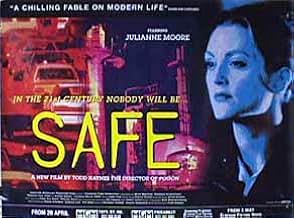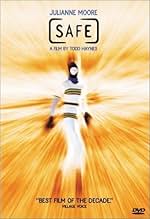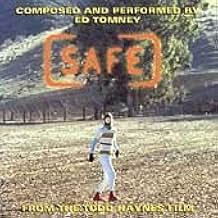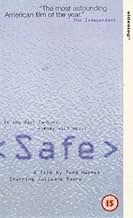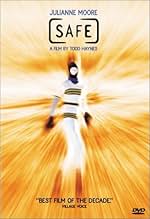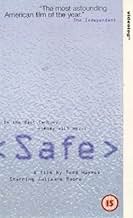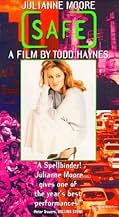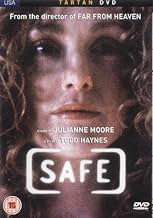AVALIAÇÃO DA IMDb
7,1/10
19 mil
SUA AVALIAÇÃO
Uma dona de casa abastada e excepcional dos subúrbios desenvolve múltiplas sensibilidades químicas.Uma dona de casa abastada e excepcional dos subúrbios desenvolve múltiplas sensibilidades químicas.Uma dona de casa abastada e excepcional dos subúrbios desenvolve múltiplas sensibilidades químicas.
- Prêmios
- 4 vitórias e 13 indicações no total
Martha Velez
- Fulvia
- (as Martha Velez-Johnson)
Chauncey Leopardi
- Rory
- (as Chauncy Leopardi)
Allan Wasserman
- Client
- (as Alan Wasserman)
Jean St. James
- Client's Wife
- (as Jean Pflieger)
Avaliações em destaque
Safe is perhaps a tad too ambiguous for its own good. The film focuses on a suburban housewife (Julianne Moore) who feels sick for no reason. Her doctor suggests psychological treatment, but she finds more comfort in the idea that her sickness is caused by environmental factors, such as car fumes and the like. Haynes never answers the question of what is really affecting Moore. One moment you're sure it's psychological, then physical symptoms displayed by the woman are undeniable. It's not that I really wanted the questions answered, but the constant toying with the audience does become a strain, especially as the film runs for two hours and not much happens. There's also the possibility that the story isn't meant to represent reality, but instead it might be allegorical. This makes it all the more difficult to unravel. I know I sound sort of negative in this review, but I did like it. I don't think it works completely, but I found it fascinating. One reason it does work at all is that Haynes' major goal seems to want to put us inside Moore's head. It shows us what it would be like to suffer and not know why, and how comfortable it might be to, say, join a cult, which is basically what she does in the end. Not entirely satisfying, but definitely well worth a look.
9Lleu
I call this an important film because it deals with a very topical social issue in an original and subtle manner. It is also ambiguous (as the previous reviewer pointed out), which is something American audiences and critics often can't handle. Carol, an affluent suburban housewife played by Julianne Moore, is becoming increasingly disturbed and unable to cope with the alleged pollution and impurities in the environment. What could have been a "disease of the week" TV movie, however, is handled with surprising depth by director Todd Haynes. Carol ends up in a new agey community dedicated to healing people like herself. What is fascinating is that Safe, while exploring the pressures and toxicity of modern life, is also a brilliant look at the pathology of fleeing from life and seeking an environment of "purity." For Carol ends up, instead of recovering, more and more alienated and withdrawn. Safe does not provide answers to this dilemma, but it sure makes us look at some difficult questions.
Although it's been almost ten years since filmmaker Todd Haynes (Velvet Goldmine, Far From Heaven) made Safe, the film's only secured cinematic release in Australia in 2004. As Safe quietly satirises the 80s, the delayed release improves it, adding another layer of perspective to a heroine who lives life in a series of bubbles.
It's 1987, and timid California housewife Carol (a young Julianne Moore) is immersed in upper-middle class minutiae ensuring her couch is the right colour, sleepwalking through a tepid aerobics class, and submitting to her husband (Greg White from 24). But gradually cracks appear in this pristine life, tiredness, unexplained illness until she is diagnosed with multiple chemical sensitivity. She then moves to Wrenwood, a healing retreat founded by the charismatic Peter (Peter Friedman) but will this solve her problem? Or is it just another escape? Safe is a very interesting film about a woman so overwhelmed by her environment that she becomes allergic to it. Writer and director Haynes has combined aspects of the disease film (e.g. Love Story) with the psychological thriller as Carol doesn't know what triggers her symptoms, the audience never knows when she'll have another attack.
While Haymes criticises the New Age belief that illness is psychologically-based, in Carol's case, it's impossible to separate the psychological and physical aspects of her illness. The cinematography shows her dwarfed by her environment and Haymes offers no easy solutions. ***½/***** stars.
It's 1987, and timid California housewife Carol (a young Julianne Moore) is immersed in upper-middle class minutiae ensuring her couch is the right colour, sleepwalking through a tepid aerobics class, and submitting to her husband (Greg White from 24). But gradually cracks appear in this pristine life, tiredness, unexplained illness until she is diagnosed with multiple chemical sensitivity. She then moves to Wrenwood, a healing retreat founded by the charismatic Peter (Peter Friedman) but will this solve her problem? Or is it just another escape? Safe is a very interesting film about a woman so overwhelmed by her environment that she becomes allergic to it. Writer and director Haynes has combined aspects of the disease film (e.g. Love Story) with the psychological thriller as Carol doesn't know what triggers her symptoms, the audience never knows when she'll have another attack.
While Haymes criticises the New Age belief that illness is psychologically-based, in Carol's case, it's impossible to separate the psychological and physical aspects of her illness. The cinematography shows her dwarfed by her environment and Haymes offers no easy solutions. ***½/***** stars.
Todd Haynes's modern melodrama, Safe (1995), has proven to be quite a controversial film for debate amongst film critics. Those who enjoyed the film defended it as an excellent critique on the twentieth century while others claimed it to be slow and boring. Although, as the study of film progresses Safe is being viewed under a differently light and becoming more accepted amongst American movie goers, developing what looks like the beginnings of a cult following. I would side with those who agree that the film is an excellent critique of the twentieth century although that is not my focus of analysis for this commentary.
The real focus of analysis involves one extremely short scene: where Carol White comes home and stares at the new furniture after it has been brought into the house a second time, which was about half way through the film. The mise-en-scene in this short five to ten second shot is extraordinary in its capture of the mood or in Carol White's case the sickness behind suburban life.
The new couch alone was the most powerful aspect of mise-en-scene. There it was, black in color, square in shape, perfectly spaced between the walls and lamps. The couch is empty and unused yet filling in space and suburban peace of mind. It is the focus of the entire shot, forcing the audience to stare on waiting for a reaction, some kind of acknowledgment from Carol White. The couch, to me, has essentially become a reflection of Carol White, fitting since her name is just as blank and lifeless as the couch.
I also thought the lighting of the room was crucial in creating the setting for the couch. The low key lighting of the enclosed room shuts out all life, helping to create that dead environment which Carol White cannot seem to escape. The darker scene really blurs the edges of the couch and the corners of the walls, forming a cave like design. This particular aspect of light really adds to the frighteningly scary mood which is most commonly felt and scene by audience members, but never really thought about or understood.
Sound and lack of it really set the tone for hidden narratives of suburban horror. The beginning of the short scene depicts Carol White walking in the darkened room to see the new couch, and only her light footsteps are heard. After this there is complete silence for at least five to ten seconds. Since the scene did not have any muffled background sounds I found it to be quite useful in describing the silence in which Carol White lives her life. Even the furniture is louder than she.
The style of mise-en-scene in this scene is quite evident throughout the rest of the film, and really shows its importance as a tool in every cinematic genre. A film such as Safe demands attention to detail and a unique style when it comes to mise-en-scene. One should always take the time to stop and enjoy the symbols, messages, and hidden narratives behind mise-en-scene.
The real focus of analysis involves one extremely short scene: where Carol White comes home and stares at the new furniture after it has been brought into the house a second time, which was about half way through the film. The mise-en-scene in this short five to ten second shot is extraordinary in its capture of the mood or in Carol White's case the sickness behind suburban life.
The new couch alone was the most powerful aspect of mise-en-scene. There it was, black in color, square in shape, perfectly spaced between the walls and lamps. The couch is empty and unused yet filling in space and suburban peace of mind. It is the focus of the entire shot, forcing the audience to stare on waiting for a reaction, some kind of acknowledgment from Carol White. The couch, to me, has essentially become a reflection of Carol White, fitting since her name is just as blank and lifeless as the couch.
I also thought the lighting of the room was crucial in creating the setting for the couch. The low key lighting of the enclosed room shuts out all life, helping to create that dead environment which Carol White cannot seem to escape. The darker scene really blurs the edges of the couch and the corners of the walls, forming a cave like design. This particular aspect of light really adds to the frighteningly scary mood which is most commonly felt and scene by audience members, but never really thought about or understood.
Sound and lack of it really set the tone for hidden narratives of suburban horror. The beginning of the short scene depicts Carol White walking in the darkened room to see the new couch, and only her light footsteps are heard. After this there is complete silence for at least five to ten seconds. Since the scene did not have any muffled background sounds I found it to be quite useful in describing the silence in which Carol White lives her life. Even the furniture is louder than she.
The style of mise-en-scene in this scene is quite evident throughout the rest of the film, and really shows its importance as a tool in every cinematic genre. A film such as Safe demands attention to detail and a unique style when it comes to mise-en-scene. One should always take the time to stop and enjoy the symbols, messages, and hidden narratives behind mise-en-scene.
'Safe' is enigmatic, anxious, bewildering and captivating. It will divide viewers, but I argue that this is the hallmark of all true art. You will either love it or hate it, you will either get it or you won't. But it won't leave you indifferent.
Julianne Moore plays Carol White, the film's childlike protagonist with a phenomenal skill. In the hands of a more showy, ostentatious actress, Carol's 'illness' could have appeared trivial, her character, flighty, whiny and irritating. In the hands of Julianne Moore who is, in my opinion, the most intelligent, thoughtful and captivating actress working today, Carol's predicament is moving amd her character endearing. Her performance truly is astonishing. Never does she feel the need to overact, to emphasise Carol's confusion or her fear. She plays her with a childlike acceptance, a surface simplicity and a sing-songy girlish voice, and she is a master of restraint, implication, understatement. I have yet to see a more impressive performance from an actress whose skill lies in making it appear like she is doing very little, when really there is a huge amount going on underneath the surface. The film would be worth it for Julianne Moore alone, but it also has other things to reccommend it.
There's the excellent direction from the genius, Todd Haynes. His mainstream hit, the wonderful homage to Sirk 'Far From Heaven' catapulted Haynes into the mainstream, but I find this work even more affecting. Haynes is a genius at utilising the mise-en-scene for the maximum effect. He uses his camera as a painter would with colour - each shot is masterfully composed, with the director never allowing us to get too close to Julianne Moore's character, making her predicament all the more confusing and alienating. This is a film which demands thought and concentration, and what you take from it will depend upon individual disposition and experience.
The dialogue is generally sparse and quite functional, meaning that emphasis is placed onto the menacing soundtrack (giving the film a horror/thriller feel), the meticulously orchestrated mise-en-scene and, of course, the amazing nuances and depth of Julianne Moore's artistic gifts. In terms of what the film is trying to say, there is a real sense of satire in the second section of the film (When Carol goes to the commune to be 'cured') but there is no insistence upon one single message. This is reflected with a deeply ambiguous ending which leaves one feeling anxious and confused.
Overall, 'Safe' is a masterful piece of work. The team of Julianne Moore and Todd Haynes is (as we have seen with 'Far From Heaven') a match made ... in heaven. I would urge those who appreciate non maintream, thought provoking and unconventional films to give it try, just don't go in with 'Hollywood' expectations as you will be disappointed. Finally, I'd like to end by reiterating what is possibly the film's main strength - the presence of Julianne Moore. This truly is a captivating performance from her, and certainly one of the most astonishing I am likely ever to see. 'Safe' gives us the chance to watch this gifted actress in one of her most underrated, little seen, yet most remarkable roles.
Julianne Moore plays Carol White, the film's childlike protagonist with a phenomenal skill. In the hands of a more showy, ostentatious actress, Carol's 'illness' could have appeared trivial, her character, flighty, whiny and irritating. In the hands of Julianne Moore who is, in my opinion, the most intelligent, thoughtful and captivating actress working today, Carol's predicament is moving amd her character endearing. Her performance truly is astonishing. Never does she feel the need to overact, to emphasise Carol's confusion or her fear. She plays her with a childlike acceptance, a surface simplicity and a sing-songy girlish voice, and she is a master of restraint, implication, understatement. I have yet to see a more impressive performance from an actress whose skill lies in making it appear like she is doing very little, when really there is a huge amount going on underneath the surface. The film would be worth it for Julianne Moore alone, but it also has other things to reccommend it.
There's the excellent direction from the genius, Todd Haynes. His mainstream hit, the wonderful homage to Sirk 'Far From Heaven' catapulted Haynes into the mainstream, but I find this work even more affecting. Haynes is a genius at utilising the mise-en-scene for the maximum effect. He uses his camera as a painter would with colour - each shot is masterfully composed, with the director never allowing us to get too close to Julianne Moore's character, making her predicament all the more confusing and alienating. This is a film which demands thought and concentration, and what you take from it will depend upon individual disposition and experience.
The dialogue is generally sparse and quite functional, meaning that emphasis is placed onto the menacing soundtrack (giving the film a horror/thriller feel), the meticulously orchestrated mise-en-scene and, of course, the amazing nuances and depth of Julianne Moore's artistic gifts. In terms of what the film is trying to say, there is a real sense of satire in the second section of the film (When Carol goes to the commune to be 'cured') but there is no insistence upon one single message. This is reflected with a deeply ambiguous ending which leaves one feeling anxious and confused.
Overall, 'Safe' is a masterful piece of work. The team of Julianne Moore and Todd Haynes is (as we have seen with 'Far From Heaven') a match made ... in heaven. I would urge those who appreciate non maintream, thought provoking and unconventional films to give it try, just don't go in with 'Hollywood' expectations as you will be disappointed. Finally, I'd like to end by reiterating what is possibly the film's main strength - the presence of Julianne Moore. This truly is a captivating performance from her, and certainly one of the most astonishing I am likely ever to see. 'Safe' gives us the chance to watch this gifted actress in one of her most underrated, little seen, yet most remarkable roles.
Você sabia?
- CuriosidadesWhen it came time for Julianne Moore to record the director's commentary for the 2003 DVD release, this was the first time the lead actress had seen the movie in its entirety.
- Erros de gravaçãoAlthough this film was explicitly set in 1987, while Carol is driving on the highway, she passes a burgundy 1992 Cadillac de Ville.
- Citações
Carol White: [about her declining health] I'm sorry. I know it's not normal but I can't help it.
Principais escolhas
Faça login para avaliar e ver a lista de recomendações personalizadas
- How long is Safe?Fornecido pela Alexa
Detalhes
- Data de lançamento
- Países de origem
- Idiomas
- Também conhecido como
- A Salvo
- Locações de filme
- Empresas de produção
- Consulte mais créditos da empresa na IMDbPro
Bilheteria
- Orçamento
- US$ 1.000.000 (estimativa)
- Faturamento bruto nos EUA e Canadá
- US$ 512.245
- Fim de semana de estreia nos EUA e Canadá
- US$ 15.830
- 25 de jun. de 1995
- Faturamento bruto mundial
- US$ 512.558
Contribua para esta página
Sugerir uma alteração ou adicionar conteúdo ausente

Principal brecha
By what name was Mal do Século (1995) officially released in India in English?
Responda

